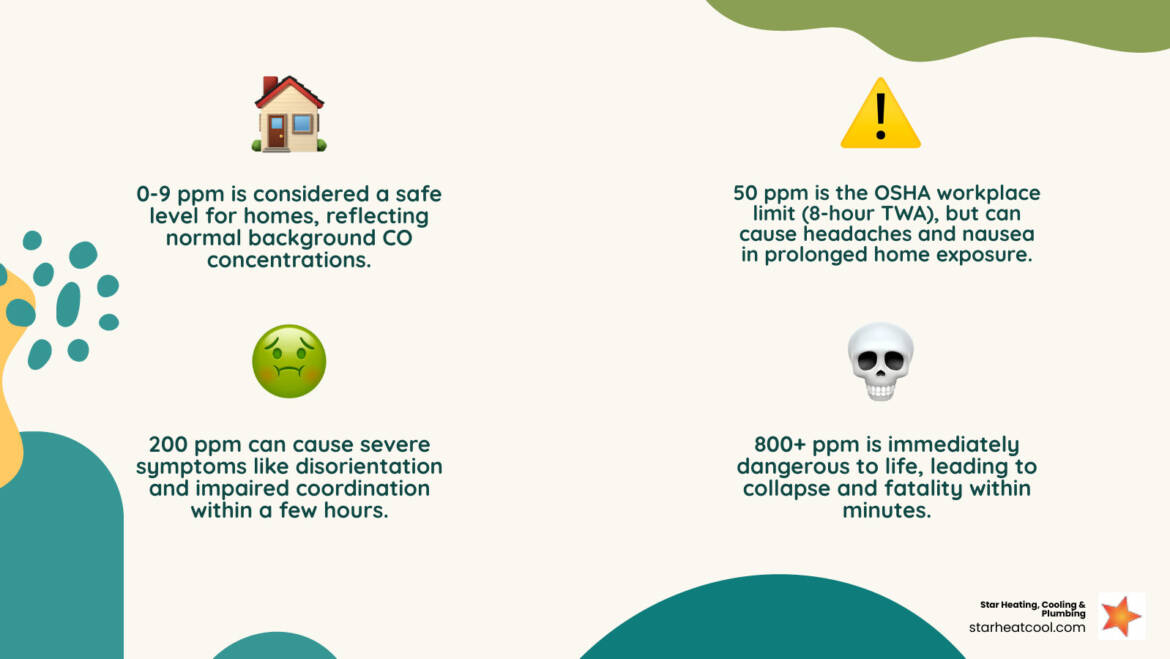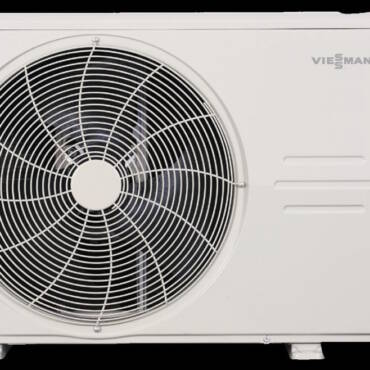Understanding Carbon Monoxide Exposure and Safety Levels
50 ppm CO is the maximum exposure limit set by OSHA for workplaces over an 8-hour period. However, this industrial standard is not safe for your home. For homeowners in Fishers, IN, understanding carbon monoxide levels is key to protecting your family from this invisible, odorless threat from fuel-burning appliances like your furnace or water heater.
Quick Answer: Is 50 ppm CO Safe?
- 50 ppm CO is the OSHA workplace limit for an 8-hour workday
- Not recommended for homes – residential safe levels are much lower (0-9 ppm)
- Health effects at 50 ppm: headaches, fatigue, nausea, and impaired coordination
- Higher risk groups: children, elderly, and those with heart or lung conditions
- Home safety standard: EPA recommends 9 ppm or less over 8 hours
If you’re concerned about carbon monoxide in your home, learn more about indoor air quality solutions or schedule a safety inspection with our trusted team.
Carbon monoxide is a leading cause of poisoning deaths worldwide. Even at levels below 50 ppm, prolonged exposure can cause serious health problems, especially for children, the elderly, and those with chronic health conditions. Since CO is undetectable by human senses, proper monitoring equipment is essential for every home.
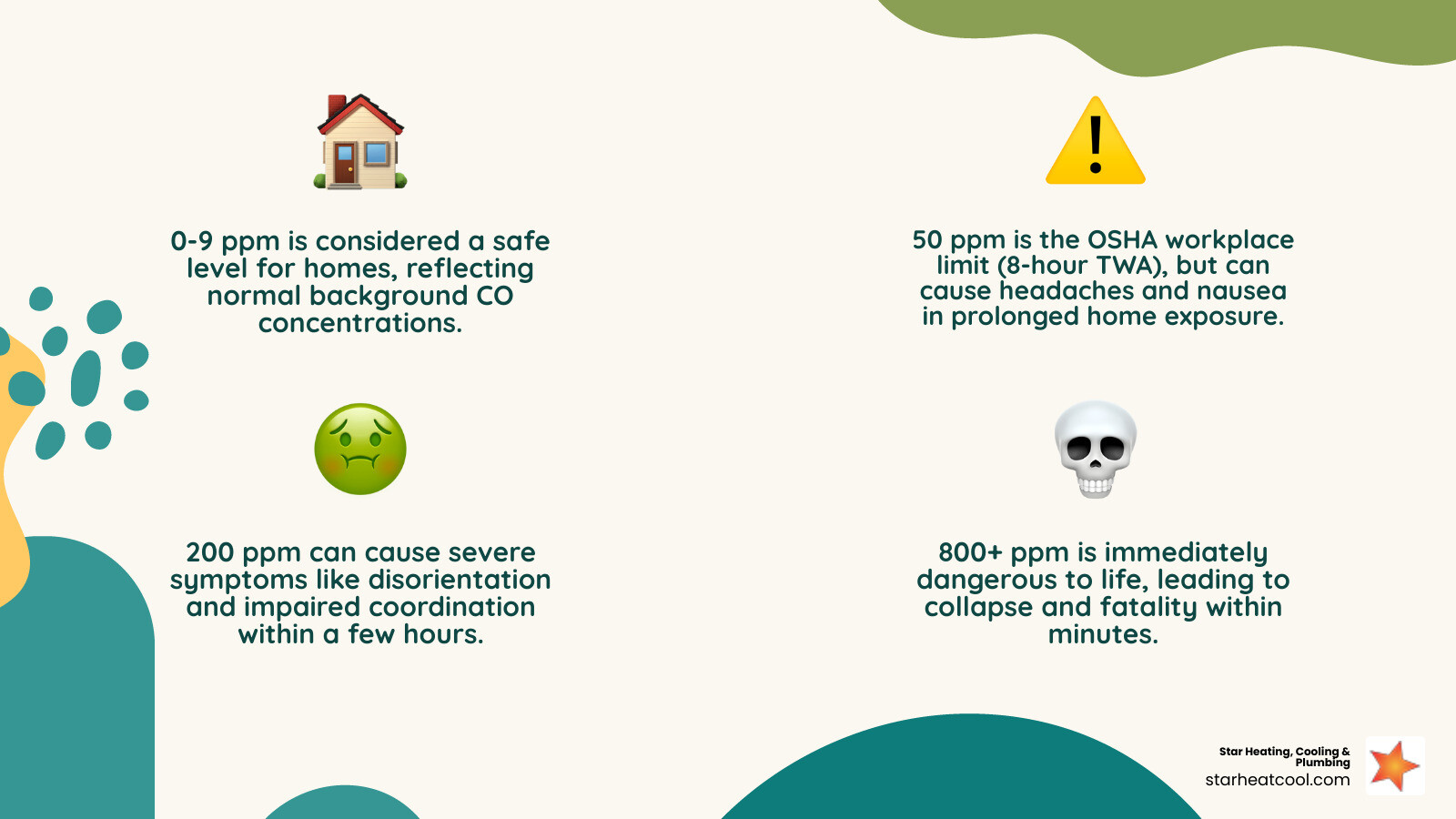
At Star Heating, Cooling & Plumbing, we believe an informed homeowner is a safe homeowner. This guide will help you understand CO levels, their health effects, and how to protect your family in Fishers, IN, and surrounding areas like Carmel, Indianapolis, and Noblesville.
Decoding CO Levels: From Safe to Dangerous
Carbon monoxide is formed by the incomplete burning of fuel. Appliances like your furnace, water heater, and fireplace all produce CO. While normally vented outside, this colorless and odorless gas becomes dangerous when it builds up in enclosed spaces.
When inhaled, CO enters the bloodstream and binds to hemoglobin—the part of your red blood cells that carries oxygen. Because CO binds over 200 times more effectively than oxygen, it starves your brain, heart, and other vital organs of the oxygen they need to function. This is carbon monoxide poisoning.
We measure CO concentration in parts per million (PPM). The danger of a specific PPM level depends on the duration of exposure.
- Low-level exposure: Sustained exposure to levels below 50 ppm CO can cause flu-like symptoms such as headaches, fatigue, dizziness, and nausea. These are often misdiagnosed, allowing the exposure to continue.
- High-level exposure: At 200 ppm, symptoms become severe, and exposure can be fatal within hours. At 800 ppm or more, unconsciousness and death can occur in minutes.
Vulnerable populations like children, the elderly, pregnant women, and individuals with heart or respiratory conditions are at a much greater risk from any level of CO exposure.
For comprehensive information about the dangers of CO, check out the Carbon Monoxide Poisoning Fact Sheet from the CDC. And if you’re wondering whether you need CO detectors in your home (spoiler: you absolutely do), we’ve written extensively about why your home needs carbon monoxide detectors.
What are Safe vs. Unsafe CO Concentrations?
Let’s break down what the numbers mean for your family’s safety.

- 0-9 ppm (Safe): Normal background levels in a home are typically 0.5-5 ppm. The EPA and ASHRAE recommend keeping indoor levels below 9 ppm over an 8-hour period. This is the gold standard for home safety.
- 10-35 ppm (Concerning): At these levels, you may experience reduced exercise capacity. Those with heart disease may feel chest pain. A poorly adjusted gas stove can produce levels of 30 ppm or more.
- 35-100 ppm (Dangerous): At 35 ppm, firefighters are required to wear oxygen masks. Around 100 ppm, you will likely develop headaches, fatigue, and nausea within two hours.
- 200+ ppm (Very Dangerous): NIOSH and OSHA recommend immediate evacuation. Headaches and nausea will occur, and prolonged exposure can be fatal.
- 800+ ppm (Immediately Life-Threatening): At 800 ppm, you can lose consciousness within two hours and die shortly after. At very high concentrations (e.g., a car running in a closed garage), death can occur in minutes.
Long-Term Effects of Low-Level Exposure
High-level CO exposure is an acute emergency, but the long-term effects of low-level exposure are just as dangerous. This is known as chronic exposure.
Constant exposure to low CO concentrations—even below 50 ppm CO—can seriously impact your health over time. The symptoms are often subtle and misdiagnosed as chronic fatigue, depression, or the flu. They include persistent headaches, deep fatigue that doesn’t improve with rest, memory problems, and difficulty concentrating.
This happens because CO in your blood forms carboxyhemoglobin (COHb), which reduces your body’s ability to carry oxygen. Over time, this chronic oxygen deprivation damages your brain, heart, and other organs. Vulnerable individuals are especially at risk; studies show that even very low levels (3-7 ppm) can increase asthma hospitalizations, and exposure during pregnancy can harm fetal development.
You don’t need a major emergency to suffer real harm from carbon monoxide. Learn how to stay safe from carbon monoxide in the home with proper monitoring and maintenance.
The Critical Threshold: Understanding 50 ppm CO
The 50 ppm CO figure is a workplace safety standard set by OSHA (the Occupational Safety and Health Administration). It is the PEL (Permissible Exposure Limit) for a healthy adult worker over an 8-hour workday, known as a time-weighted average (TWA).
The critical distinction for homeowners is the difference between industrial settings vs. residential concern. The 50 ppm limit was not designed for the 24/7 exposure of a home environment, nor does it account for vulnerable individuals like children, the elderly, or those with health conditions.
Your home in Fishers, IN, requires a much stricter standard. You are there for more than 8 hours, and your entire family, including the most vulnerable, needs to be protected. Residential CO levels should remain well below the 50 ppm CO threshold—ideally under 9 ppm for continuous exposure. Understanding this difference is vital for your family’s safety. For practical steps, read our guide on how to stay safe from carbon monoxide in the home.
Health Effects of Sustained 50 ppm CO
Even at the workplace limit of 50 ppm CO, sustained exposure can cause mild poisoning symptoms. These include a persistent headache, dizziness, nausea, and impaired coordination. These symptoms can develop gradually from a slow leak and are often mistaken for the flu or stress.
The danger is significantly higher for vulnerable individuals.
- Risk to children: Their faster metabolism means they absorb CO more quickly, and their developing brains are more susceptible to oxygen deprivation.
- Risk to elderly: Pre-existing health conditions and reduced lung capacity make them less able to tolerate CO exposure.
- Risk to people with heart disease: For those with conditions like angina, 50 ppm CO can trigger chest pain and serious cardiac events by further restricting the heart’s oxygen supply.
This is why a workplace standard is inadequate for a home environment, which must be safe for everyone.
Regulatory Standards Around 50 ppm CO
Several organizations set workplace CO exposure limits, which highlights why a single standard isn’t a simple matter.
- OSHA (Occupational Safety and Health Administration): Sets the legally enforceable PEL (Permissible Exposure Limit) at 50 ppm CO over an 8-hour workday.
- NIOSH (National Institute for Occupational Safety and Health): Recommends a more conservative REL (Recommended Exposure Limit) of 35 ppm over 8 hours, based on health research.
- ACGIH (American Conference of Governmental Industrial Hygienists): Provides a TLV-TWA (Threshold Limit Value) guideline of 50 ppm CO for an 8-hour day.
Here’s a quick comparison to help you see how these standards stack up:
| Organization | What It Means | 8-Hour Limit | Short-Term Limit | Legal Status |
|---|---|---|---|---|
| OSHA | Occupational Safety and Health Administration | 50 ppm CO | 200 ppm (maritime only) | Legally required |
| NIOSH | National Institute for Occupational Safety and Health | 35 ppm | 200 ppm (15 min) | Recommended |
| ACGIH | American Conference of Governmental Industrial Hygienists | 50 ppm CO | 400 ppm | Guideline |
The disagreement among experts, with NIOSH recommending a lower limit of 35 ppm, underscores that these are minimum standards for workplaces, not safety targets for your home. For more details, see the OSHA Carbon Monoxide Fact Sheet.
At Star Heating, Cooling & Plumbing, we aim to keep CO levels in your home as close to zero as possible, far below the 50 ppm CO workplace limit.
Protecting Your Home: Monitoring and Mitigation
Since carbon monoxide is undetectable by your senses, protecting your home requires a proactive approach. Home CO safety is built on three pillars: reliable CO detectors, professional maintenance, and proper ventilation.
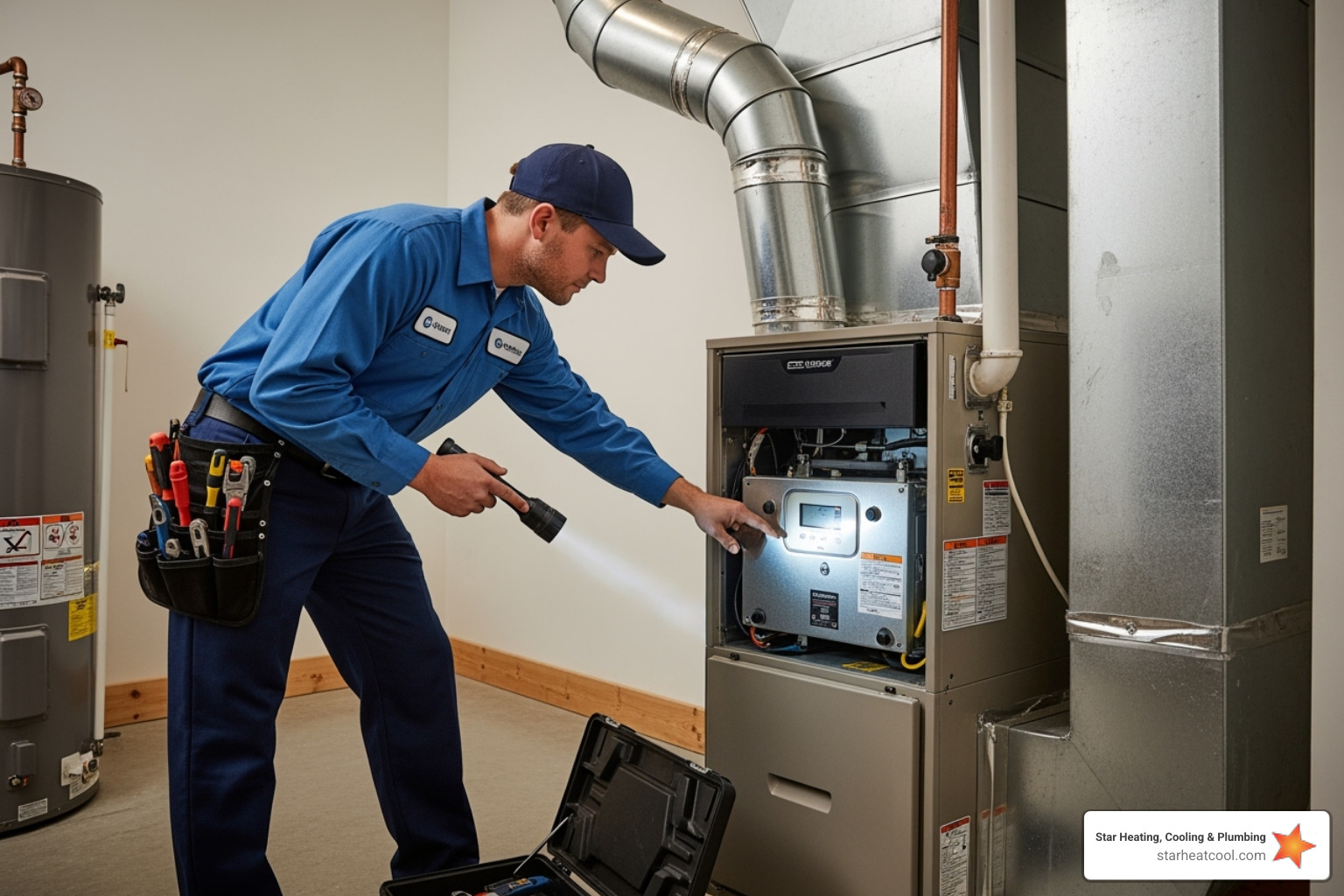
Common CO sources include any fuel-burning appliance: your furnace, water heater, gas stove, clothes dryer, fireplace, or a car in an attached garage. If these items malfunction or are not vented correctly, they can release CO into your home. Even levels far below 50 ppm CO can be a problem with continuous exposure, making prevention critical. A small crack in a heat exchanger or a blocked flue can allow CO to seep into your living space. Learn more about how to reduce the chance of a carbon monoxide leak in the home.
CO Detectors: Your First Line of Defense
CO detectors are your only way of knowing if carbon monoxide is present. Proper installation and maintenance are key.
- Placement is critical: Install detectors on every level of your home, especially outside sleeping areas. Mount them at chest or head height, away from drafts, windows, and fuel-burning appliances that could cause false alarms.
- Types of detectors: You can choose flexible battery-operated models (many with 10-year batteries) or hardwired detectors with battery backup.
- Digital displays are recommended: These show the exact PPM level, allowing you to spot slow leaks before they become emergencies.
- Look for UL 2034 certification: This ensures the alarm is calibrated to sound at specific danger thresholds (e.g., within 1-4 hours at 70 ppm) while avoiding nuisance alarms from minor fluctuations.
Our team offers carbon monoxide detector services in Fishers, IN to help you choose and install the right detectors for your home.
Proactive Prevention and Maintenance
Preventing CO problems is even better than just detecting them. Most leaks stem from poorly maintained or improperly installed equipment.
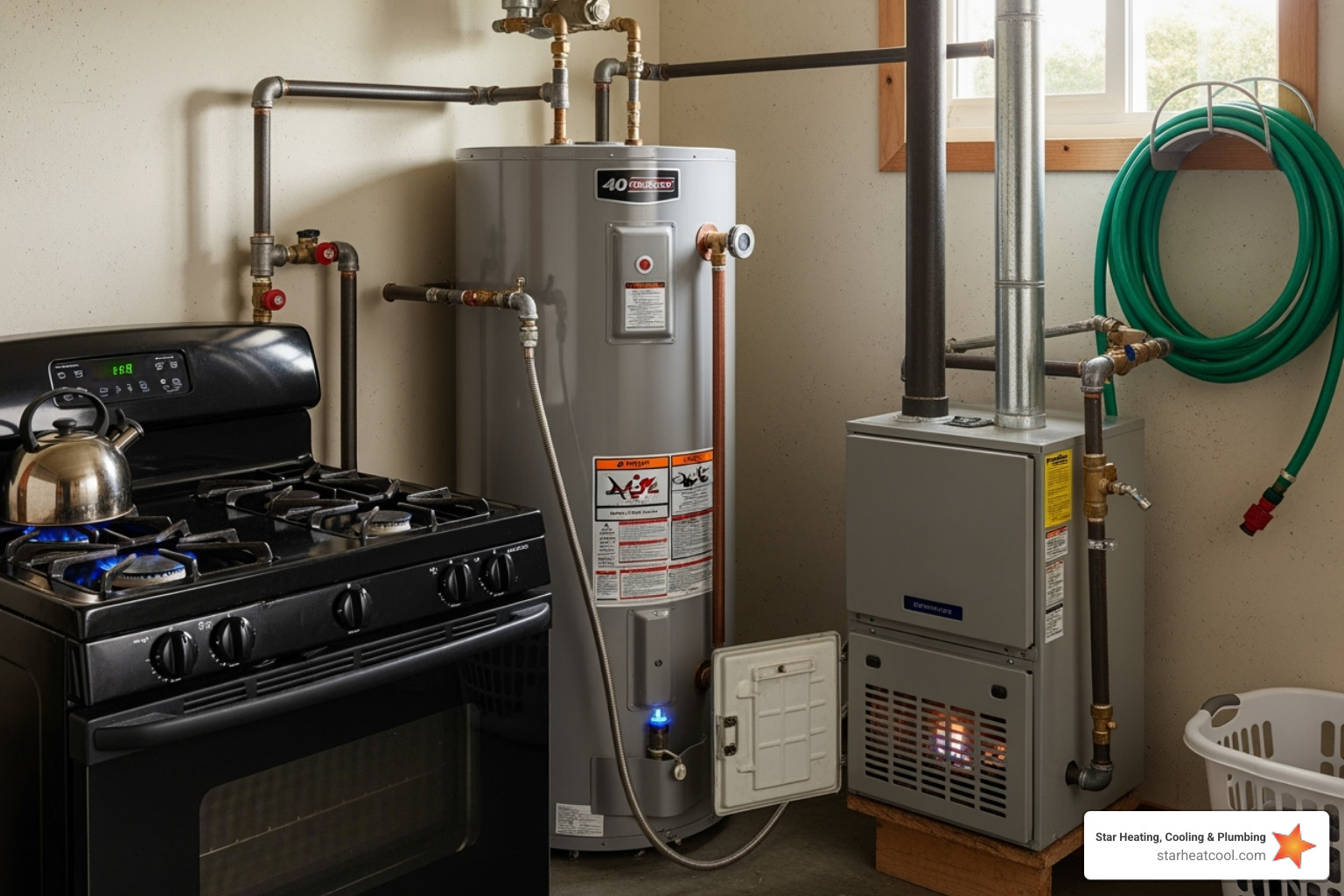
- Schedule annual HVAC inspections: This is essential for safety. A certified technician can find cracks in the heat exchanger, blocked vents, and other issues that could lead to a CO leak.
- Maintain all fuel-burning appliances: Your gas water heater, stove, and clothes dryer also need regular professional checks to ensure they are venting properly.
- Ensure proper ventilation: Check that kitchen and bathroom exhaust fans vent to the outdoors. Keep your fireplace flue open when in use and have your chimney cleaned and inspected regularly.
- Practice attached garage safety: Never run a car, generator, or any gasoline-powered engine inside an attached garage, even with the door open. CO can easily seep into your home. Run generators outdoors and far away from windows and doors.
Regular maintenance is a win-win: it protects your family’s safety and keeps your equipment running efficiently.
Frequently Asked Questions about Carbon Monoxide
We hear a lot of questions about carbon monoxide from homeowners throughout Fishers, Greenwood, Westfield, and Zionsville. It’s completely natural to have concerns about this invisible threat, and we’re here to provide the clear, straightforward answers you need to keep your family safe.
What is a “normal” CO level in a house?
In a well-maintained home, typical levels should be between 0.5 and 5 ppm. A properly working gas stove might temporarily produce levels of 5 to 15 ppm while in use, but a malfunctioning one can create levels of 30 ppm or higher, highlighting the need for properly adjusted appliances.
You should be concerned if your digital CO detector shows a persistent reading above 9 ppm, the level considered safe by the EPA for 8-hour exposure. If you see higher readings or anyone experiences CO-related symptoms, investigate the cause immediately.
Can small amounts of carbon monoxide make you sick over time?
Yes. Small amounts of carbon monoxide can make you sick over time through a process called chronic exposure. Sustained exposure to even low levels (e.g., 15-20 ppm) can cause subtle symptoms like persistent headaches, fatigue, nausea, and memory problems. These are often misdiagnosed, allowing the dangerous exposure to continue.
This underscores the importance of low-level detection. A CO detector with a digital display can alert you to these persistent low levels, giving you an early warning to address a potential leak before it causes serious health issues. Learn more in our guide: should you install carbon monoxide detectors in your indianapolis home.
What should I do if my CO alarm goes off?
If your CO alarm sounds, act immediately. Your life could depend on it.
- Evacuate immediately. Get everyone, including pets, out of the house and into fresh air. Do not stop to gather belongings.
- Call 911 from a safe location outside. Tell the dispatcher your carbon monoxide alarm is going off.
- Do not re-enter the home. Wait for emergency responders to arrive and declare the area safe.
- Call a professional after the emergency is over. A qualified technician from a company like Star Heating, Cooling & Plumbing can find and repair the source of the leak.
Always treat every alarm as a real emergency. While you may wonder can a carbon monoxide detector go off for no reason, the risk of ignoring a real alarm is too great.
Ensure Your Family’s Safety from Carbon Monoxide
Understanding carbon monoxide levels—from the safe threshold of 9 ppm to the workplace limit of 50 ppm CO—empowers you to protect your family. A workplace standard is not safe for your home, where the goal should be to keep levels as close to zero as possible.
Effective protection combines monitoring with the right CO detectors and proactive prevention. Regular, professional maintenance of your furnace, water heater, and other fuel-burning appliances is the best way to catch issues like a cracked heat exchanger or a blocked vent before they become dangerous.
At Star Heating, Cooling & Plumbing, a family-owned Carrier Factory Authorized Dealer, we have served families across Central Indiana, including Fishers, Noblesville, and McCordsville, for years. Our friendly, transparent technicians are committed to your safety and peace of mind.
Don’t wait for an alarm to sound. Be proactive by scheduling your annual HVAC inspection to ensure your home’s air is safe.
Ensure your home’s air is safe with our indoor air quality services in Fishers, IN.
Your family deserves to breathe easy, and we’re here to help make that happen.
Whether you require installation, repair, or maintenance, our technicians will assist you with top-quality service at any time of the day or night. Take comfort in knowing your indoor air quality is the best it can be with MOE heating & cooling services Ontario's solution for heating, air conditioning, and ventilation that’s cooler than the rest.
Contact us to schedule a visit. Our qualified team of technicians, are always ready to help you and guide you for heating and cooling issues. Weather you want to replace an old furnace or install a brand new air conditioner, we are here to help you. Our main office is at Kitchener but we can service most of Ontario's cities
Source link

